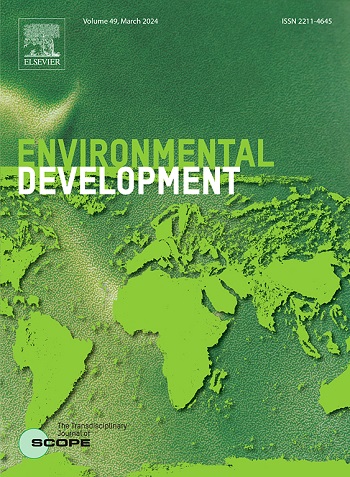南非农业干旱预警系统(ADEWS)追踪的2023/24年夏季干旱
IF 5.3
2区 环境科学与生态学
Q2 ENVIRONMENTAL SCIENCES
引用次数: 0
摘要
南非的商业粮食生产主要依靠雨养,集中在夏季降雨区的半干旱地区,在那里干旱是农业歉收的主要原因,有时导致粮食不安全。在2023/24年夏季生长期,1月中旬至3月下旬发生了一场高强度、快速发生的突发性干旱,由于南非主要主食白玉米产量下降,导致粮食价格大幅上涨。尽管干旱只持续了两个半月,但对农业的影响却很大,因为干旱恰逢玉米生长季节的高峰,即抽穗和灌浆时期。以这次干旱为例,我们评估了南非农业干旱预警系统(ADEWS)在通报干旱状况及其对生产力的影响方面的能力,该系统可在https://www.drought.agric.za/上获得。该ADEWS集成了天气数据、中短期预报、遥感数据以及作物和牧场模拟输出,提供近实时的干旱指标监测。对观测到的玉米产量进行验证显示出很强的性能,观测到的玉米产量与ADEWS的几个产品,包括植被条件指数(VCI)、玉米需水满意度指数(WRSI)、平均季节绿度百分比(PASG)和农业技术转移决策支持系统-作物环境资源综合(DSSAT-CERES-Maize)模型的模拟产量之间存在统计学显著相关性。尽管干旱持续时间有限,但ADEWS有效地捕捉到了干旱的严重程度、时间和产量影响。因此,本案例研究反映了ADEWS在使利益相关者了解情况以及支持南非雨养农业系统的早期预警和抗旱决策方面的价值。本文章由计算机程序翻译,如有差异,请以英文原文为准。
The 2023/24 summer drought tracked by the Agricultural Drought Early Warning System (ADEWS) for South Africa
Commercial grain production in South Africa is largely rainfed and concentrated in semi-arid areas in the summer rainfall region, where drought is a leading cause of low agricultural harvests, sometimes resulting in food insecurity. During the 2023/24 summer growing season, a high-intensity, rapid-onset flash drought occurred from mid-January to late March, resulting in significant grain price increases due to lower production of white maize, the main staple in South Africa. Despite only lasting two-and-a-half months, agricultural impacts were significant because the drought coincided with the peak of the maize growing season during tasselling and grain filling. Using this drought as a case study, we evaluated the ability of a South African Agricultural Drought Early Warning System (ADEWS), available at https://www.drought.agric.za/, in communicating drought conditions and impacts on productivity. This ADEWS integrates weather data, short-to medium-range forecasts, remote sensing data, and crop and rangeland simulation outputs to provide near real-time monitoring of drought indicators. Validation against observed maize yields showed strong performance, with statistically significant correlations between observed maize yields and several ADEWS products, including the Vegetation Condition Index (VCI), maize Water Requirement Satisfaction Index (WRSI), Percentage of Average Seasonal Greenness (PASG), and simulated yields from the Decision Support System for Agrotechnology Transfer – Crop Environment Resource Synthesis (DSSAT-CERES-Maize) model. Despite the limited duration of the drought, ADEWS effectively captured its severity, timing and production impacts. Therefore, this case study reflects the value of ADEWS in keeping stakeholders informed, and in supporting early warning and decision making for drought preparedness in South African rainfed agricultural systems.
求助全文
通过发布文献求助,成功后即可免费获取论文全文。
去求助
来源期刊

Environmental Development
Social Sciences-Geography, Planning and Development
CiteScore
8.40
自引率
1.90%
发文量
62
审稿时长
74 days
期刊介绍:
Environmental Development provides a future oriented, pro-active, authoritative source of information and learning for researchers, postgraduate students, policymakers, and managers, and bridges the gap between fundamental research and the application in management and policy practices. It stimulates the exchange and coupling of traditional scientific knowledge on the environment, with the experiential knowledge among decision makers and other stakeholders and also connects natural sciences and social and behavioral sciences. Environmental Development includes and promotes scientific work from the non-western world, and also strengthens the collaboration between the developed and developing world. Further it links environmental research to broader issues of economic and social-cultural developments, and is intended to shorten the delays between research and publication, while ensuring thorough peer review. Environmental Development also creates a forum for transnational communication, discussion and global action.
Environmental Development is open to a broad range of disciplines and authors. The journal welcomes, in particular, contributions from a younger generation of researchers, and papers expanding the frontiers of environmental sciences, pointing at new directions and innovative answers.
All submissions to Environmental Development are reviewed using the general criteria of quality, originality, precision, importance of topic and insights, clarity of exposition, which are in keeping with the journal''s aims and scope.
 求助内容:
求助内容: 应助结果提醒方式:
应助结果提醒方式:


